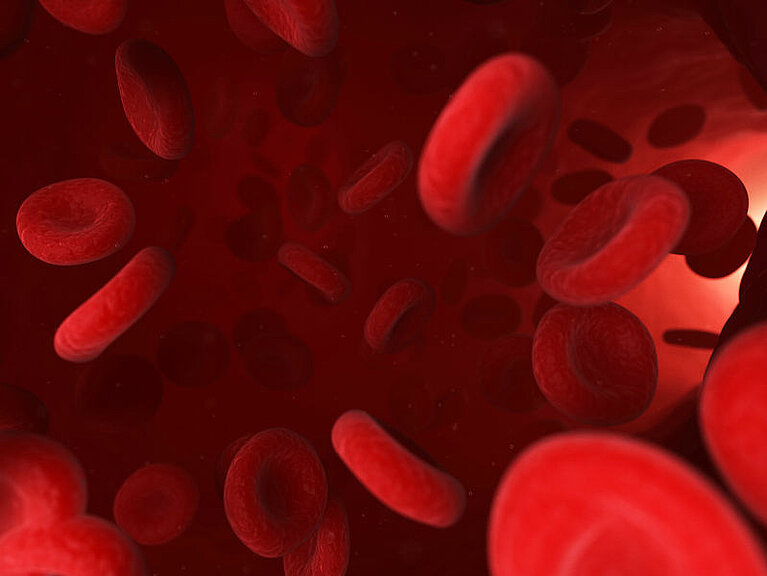July 27, 2016 - by Simone Ulmer
Based on a study done in the late 1960s, it was assumed that capillaries in the circulatory system determined the size of red blood cells. Red blood cells supply the tissues in the body with oxygen. If oxygen is to reach those tissues, red blood cells must be able to pass through capillaries finer than four microns in diameter. An international research collaboration led by Igor Pivkin, Professor of Computational Science at the Università della Svizzera italiana, has now concluded on the basis of simulations that not the capillaries, but rather the spleen could exert significant influence on the size and shape of red blood cells. The new findings were recently published in Proceedings of the National Academy of Sciences (PNAS).
Micro filter for red blood cells
The spleen is part of the lymphatic system that disposes of altered or aged blood cells. This takes place in structures called the interendothelial slits. About ten percent of the blood circulating through the spleen flows through this ‘filter’. Red blood cells are squeezed through the slits, which are 1.2 microns wide (about one eightieth of the thickness of a human hair), 4 microns long and 1.9 microns deep. Rigid and misshapen blood cells might not be able to pass through these narrow passages.
There is no experimental technique currently available that allows us to observe this process in vivo. Therefore, Igor Pivkin and colleagues used ‘Piz Daint’ to simulate the mechanical filter function of the interendothelial slit and how red blood cells are squeezed through the tiny openings. The simulations are based on the red blood cell (RBC) model which Pivkin started to develop during his PhD studies at Brown University in the group of George Karniadakis. Based on the size of the slits and taking into account the prevailing pressure difference across them, the researchers determined possible sizes and mechanical characteristics of red blood cells that would allow them to pass through the slits. They combined their simulations with a theoretical analysis, by investigating how the geometry of the slits and the blood cells influenced the process.
Survival of the fittest
It emerged that only red blood cells with a certain surface area and volume are able to pass through the filter. Their shape and size were similar to those found circulating in the blood of healthy people, which usually have a surface area of 80 to 180 square microns and a volume of 60 to 160 cubic microns. Investigations with independent laboratory experiments and a mechanical model showed similar results, according to the researchers. The scientists call this passage of cells through the interendothelial slit in the spleen the ‘physical fitness test’ for red blood cells.
Although the theory that the capillaries determine the size of red blood cells has been widely accepted since the late 1960s, it had been noticed that people without a spleen had larger red blood cells, Pivkin explains. For this reason scientists suspected that the spleen might play a role in the size and shape of red blood cells. “Our study, however, is to my knowledge the first to look into the matter and demonstrate that this indeed could be the case, indicating a new function for a well-known organ.”
Support for drug development
The findings improve the understanding of the functioning of the spleen, and how the ‘filter’ may influence disease like sickle cell anaemia or malaria. They also can provide new insights in drug treatments, for example to explain why specific malaria drugs which stiffen healthy and malaria-infected red blood cells, could lead to severe anaemia. In a media release by Massachussets Institute of Technology (MIT) co-author Subra Suresh, president of Carnegie Mellon University, emphasizes that the results offer better understanding of how the circulatory bottleneck for the red blood cell in the spleen could affect a variety of acute and chronic disease states arising from hereditary disorders, human cancers and infectious diseases, with implications for therapeutic interventions and drug efficacy assays. The work on modelling of the RBC passage through the endothelial slits in the spleen began when Pivkin joined Subra Suresh’s group at MIT as a postdoctoral researcher. However, the first signficant results were obtained years later, after Pivkin moved to USI in Lugano. The physicist Gerhard Gompper, professor at the Institute of Solid State Physics in Julich, Germany, who was not involved in the research, commented on the new findings in the same media release: “The study shows that blood-cell and blood-flow modeling and simulation have reached a stage where they can contribute significantly to the understanding and treatment of blood-related disorders”.
Reference
Pivkin IV, Peng Z, Karniadakis GE, Buffetf PA, Dao M & Suresh S: Biomechanics of red blood cells in human spleen and consequences for physiology and disease, PNAS (2016), 133, 7804-7809.
